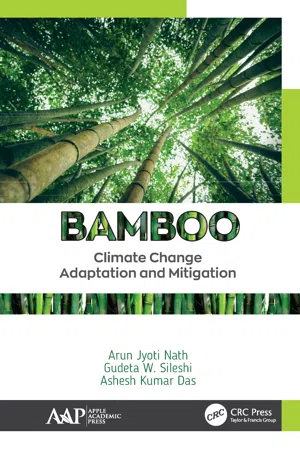
Bamboo
Climate Change Adaptation and Mitigation
- 158 pages
- English
- ePUB (mobile friendly)
- Available on iOS & Android
About This Book
This new book presents an abundance of important information and case studies that deal with bamboo farming and its effects from and on climate change adaptation and mitigation. There is a lack of research on the role of bamboo in climate change adaptation and mitigation; this volume helps to fill that gap by providing information that will enable policymakers to consider bamboo farming and its implications in carbon trading.
Bamboo represents one of the world's highest yielding renewable natural resources and is an important source of non-timber forest products for subsistence use as well as for materials with many commercial and industrial uses. There are over 1500 documented applications of bamboo products, including materials for bridges, construction, furniture, agricultural tools, handicrafts, papers, textiles, boards, edible, and bioenergy applications. With their fast growth rate and rapid propagation, bamboo forests have a high C storage potential, especially when the harvested culms are transformed into durable products and thereby prolonging the C storage.
Environmentalists love bamboo for its quick growth and for the fact that it can be harvested without harming the environment. This volume is a rich resource on the role of bamboo in ecological farming and climate change mitigation.
Key features of the book include:
• Explores the role of bamboo on climate change and environment and ecosystem-based adaptation to climate change
• Considers overlooked bamboo biomass resources
• Explains carbon capture and storage potential in bamboo
• Assesses opportunities for carbon farming and carbon trading in bamboo
• Looks at the role on bamboo cultivation on the livelihood of rural populations
• Details the soil properties needed for bamboo-based agroforestry systems
Frequently asked questions
Information
CHAPTER 1
General Introduction
1.1 Background
Table of contents
- Cover
- Half Title
- Title Page
- Copyright Page
- Dedication
- About the Authors
- Table of Contents
- Abbreviations
- Preface
- Chapter 1 General Introduction
- Chapter 2 Ecosystem Services and Human Uses of Bamboos
- Chapter 3 Soil Quality Assessment of Bamboo-Based Systems
- Chapter 4 Role of Bamboo in Ecosystem-Based Adaptation
- Chapter 5 Traditional Bamboo Products: Are They Green?
- Chapter 6 Biomass Models
- Chapter 7 Bamboo-Based Home Gardens: Opportunities for Biomass Production and Carbon Sequestration
- Chapter 8 Soil Properties and Carbon Sequestration in Bamboo-Based Systems
- Chapter 9 Carbon Farming and Carbon Trading
- Chapter 10 Challenges, Conclusions, and Recommendations
- Color insert of illustrations
- Index